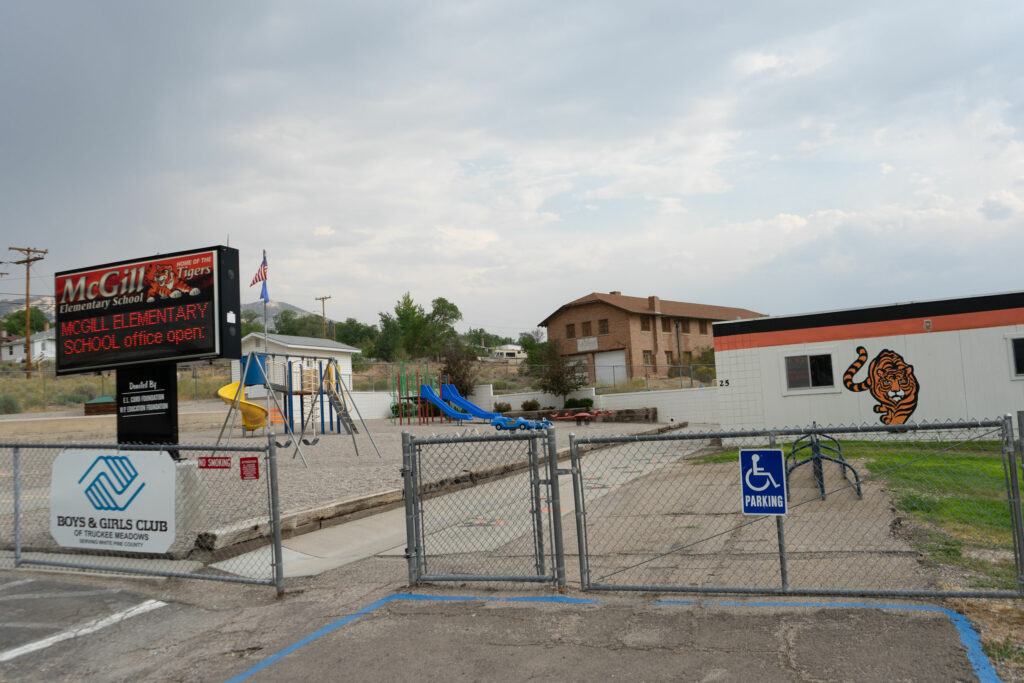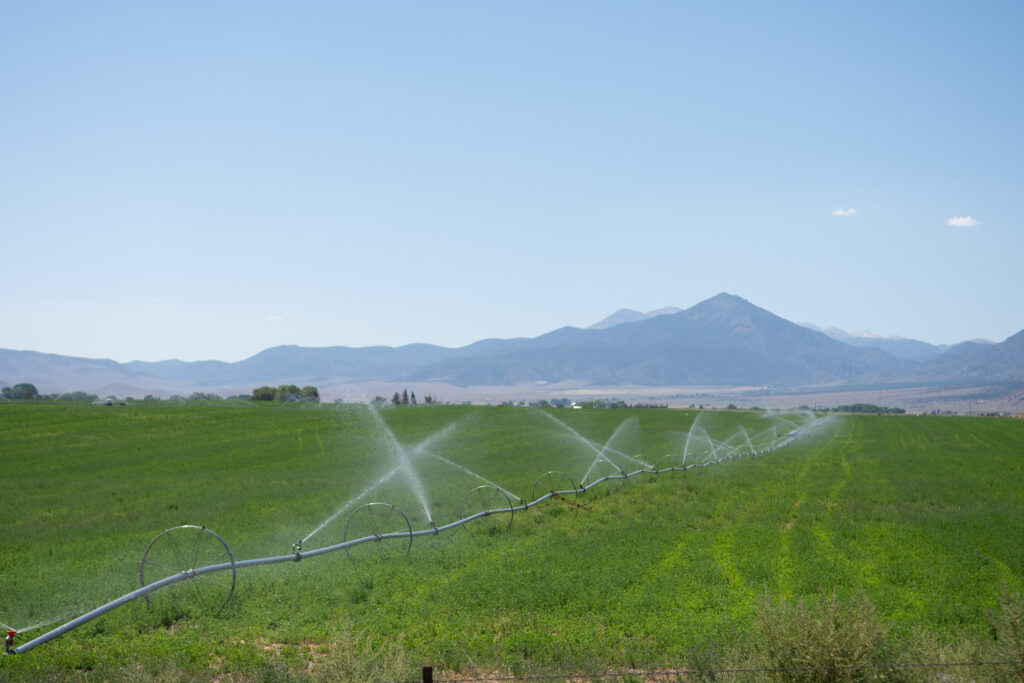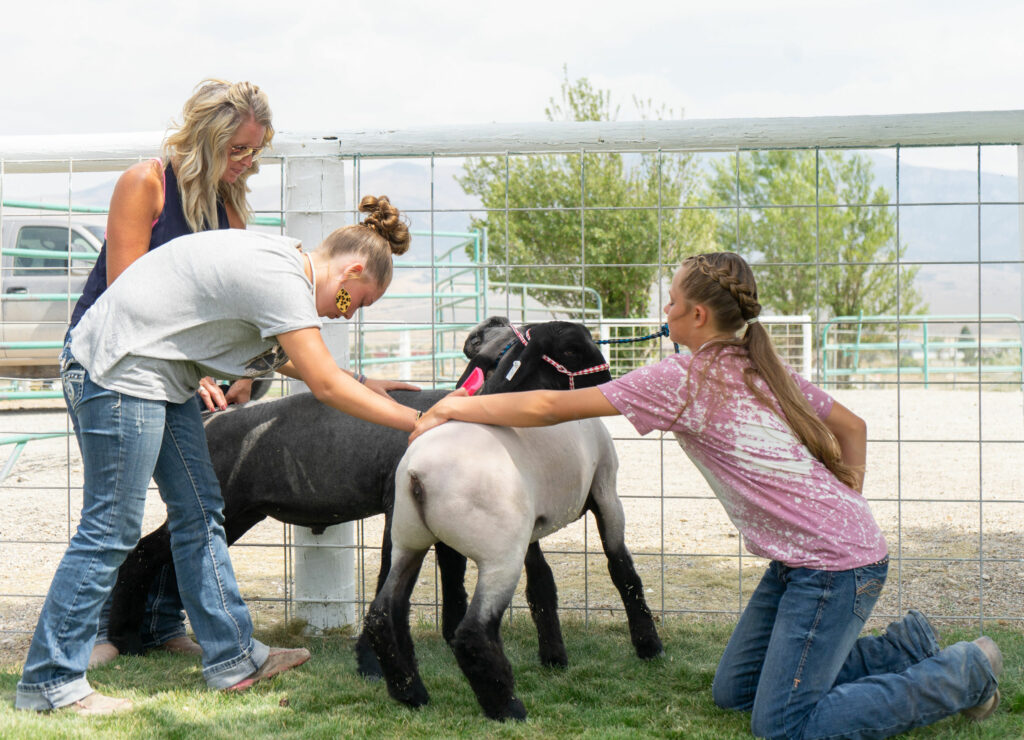In rural Nevada, bridging the education 'digital divide' largely means improving internet access

This piece is part of a collaborative reporting project called Lesson Plans: Rural schools grapple with COVID-19 created in partnership with the Institute for Nonprofit News and several member newsrooms. The project is made possible by a grant from the Walton Family Foundation.
On weekdays in the spring, Angela McVicars began her mornings as a pseudo-information technology specialist. She would log onto the internet, rousing the connection from its slumber, and try to solve any problems before the clock struck 9 a.m.
That’s when her oldest daughter logged onto Zoom for a virtual class. A half hour later, her younger daughter did the same.
Even if McVicars had successfully launched the internet, a sense of foreboding clouded their remote learning. They knew it was a matter of when, not if, the internet connection would suddenly freeze and require a manual reboot — a process that could take a handful of minutes or close to an hour if a call to their service provider was needed. And every time that happened, it meant more lost instructional minutes or precious time seeing their friends on screen.
“It got more irritating,” said her daughter, Brenley Skadburg, then a fifth-grader.
Her assessment captures the essence of the family’s distance learning experience. They live in McGill (population: 1,068), a former company town that sits along U.S. 93 in eastern-central Nevada. It’s the type of place where children take off on four-wheelers and explore the nearby mountains or bask in a local swimming hole fed by a natural spring. McVicars knew she couldn’t get away with mischief growing up here. The town chatter would reach her parents before she got home.
Now, she’s a preschool teacher at the local elementary school and her husband works for a heavy equipment dealer that serves the nearby mines. She can’t think of anywhere she would rather raise her own children.
“It’s a great little place besides the internet,” she said, “and we can all live without the internet mostly.”
But the internet hiccups became more onerous in mid-March when COVID-19 started crisscrossing the nation, forcing widespread school closures. Nevada students completed their fourth quarter remotely, either online or using paper curriculum packets. The sudden experiment unearthed a host of uncomfortable realities, including inadequate technology access.
The problem catapulted the term “digital divide” into the national vernacular seemingly overnight. If any semblance of learning was to happen outside brick-and-mortar schools, students at least needed a tablet or computer and internet access. Not everyone had both or even one. The situation caused the superintendent of the Clark County School District, which includes Las Vegas, to boldly declare he couldn’t guarantee learning for all children. But it wasn’t just large, urban districts grappling with the issue. Rural districts were feeling the crunch, too, albeit in different ways.
For McVicars and her daughters, it was the daily headaches of unreliable internet. Before the pandemic, general browsing could be hit or miss. Streaming shows or movies spawned even more glitches. So McVicars didn’t even bother trying to do her own work when her children needed the internet for school. She would either work before their online learning started or drive 13 miles to the White Pine County seat of Ely, where stronger cell signals allowed her to use her phone’s WiFi hotspot. Uploading videos — in this case, McVicars reading stories aloud to her preschoolers — went faster there.
It was another workaround the family engineered during distance learning. And spotty internet or not, McVicars said she didn’t cut her children any slack. She stepped in to help when the technology faltered and they missed a lesson. But she worries how children without parents nearby fared.
“In McGill, we’ve never had very good internet service,” she said. “That was one of my biggest worries going into this.”

A ‘magnified’ problem
McVicars’ fear wasn’t unique.
A survey conducted earlier this year by the National 4-H Council and Microsoft found that 20 percent of teens living in rural areas lack access to high-speed internet, and nearly half of those surveyed said slow internet connections impeded their ability to complete homework assignments.
Homework is one thing. An entire school day is another. And when COVID-19 shuttered schools, that became the reality.
“I think it magnified the problem,” said John Windhausen, executive director of the Schools, Health and Libraries Broadband Coalition, an advocacy organization based in Washington, D.C., that’s dedicated to closing the digital divide. “The problem had been there, but it was kind of not given enough attention.”
Some states, including Nevada, were already attempting to overcome the rural digital divide, which tends to be an access issue rather than an affordability one as in the state’s urban centers.
“In Clark and Washoe, there are huge communities that do not have access to the internet — and I should say high-speed internet — because they can’t afford it or they don’t know that they could afford it,” said Brian Mitchell, director of the Nevada Governor’s Office of Science, Innovation and Technology (OSIT). “ … In the rural areas, it could be both or it could just be access. There are people who are well off — they worked for the mines, they’ve worked for local government or other businesses — and they still may not have access to high-speed internet.”
Plus, the term “high-speed internet” can be a misnomer in less-populated areas. While service providers may call it that, the internet is barely faster than a dial-up connection in some communities, Mitchell said. It may not work if too many people are online at the same time, or buffering may occur when users try to watch a video.
The better description, he said, is “unreliable, low-speed internet.”
But, in recent years, some state-led initiatives — with the help of smaller, entrepreneurial broadband companies — have improved the internet paradigm in Nevada’s far-flung locales. OSIT launched a Whole Community Connectivity program in 2017 with a goal of attracting better broadband options for residents, businesses and public institutions such as libraries, schools and health care facilities. Since then, five counties and two municipalities have joined the initiative.
Local governments, businesses, schools, nonprofits and internet service providers have worked together to create a strategic plan that leverages investment opportunities and aggregates demand. For instance, in Ely, fiber is being laid in tandem with a Nevada Department of Transportation project along U.S. 93, which Mitchell said will improve broadband connections for the entire town.
Meanwhile, the state significantly increased its share of funds through the federal E-Rate program, which provides schools and libraries with discounts for telecommunications and internet services. The number of Nevada applicants filing for federal E-Rate funding grew by 39 percent from 2017 to 2020. The amount of funding the state received through the federal program also increased during that time period, going from $6.4 million in 2017 to $7.5 million this year.
Mitchell said some of those funds have helped pay for the steep, upfront infrastructure costs — digging trenches and laying fiber to connect rural schools with high-speed internet. The federal dollars, however, cannot be used to purchase Chromebooks or pay for internet connections inside students’ homes. That means, for example, that schools receiving E-Rate funds cannot put an antenna on their roofs and broadcast internet to surrounding neighborhoods.
In light of the pandemic and distance learning, the state sent the Federal Communications Commission a letter requesting a waiver to that rule.
“We believe that the purpose of E-Rate is to fund internet for learning and if learning is no longer taking place in the school, but it’s taking place in the home, then that should be allowed,” Mitchell said.
FCC approval of the waiver is a longshot, though. Traditionally, the FCC has opposed that arrangement because of concerns about it competing with private providers’ offerings. State officials say they could restrict network access to students’ devices while also filtering out non-educational content. The FCC has not responded to the state’s waiver request yet.
The Schools, Health and Libraries Broadband Coalition also has been lobbying Congress to make a one-time $5.25 billion appropriation to facilitate remote learning. About $4 billion would go toward expanding internet connectivity, while $1 billion would pay for devices such as tablets or Chromebooks, Windhausen said. He framed it as an investment that could pay dividends beyond the immediate remote learning needs.
“Something that’s not often talked about is that there is a racial element to this lack of connectivity because it’s tending to impact the black, Hispanic and tribal consumers at a greater rate than caucasians,” he said. “And given all of the increased attention to racial relations in this country, this is the kind of that that would help racial equity — for Congress and the state to devote resources to make sure everybody gets connected.”
Whether more federal money gets earmarked for distance education needs remains to be seen. Congress has not agreed on another coronavirus relief bill.
A mad scramble
There was no summer break for educators and state leaders trying to bridge the digital divide. Mitchell and his OSIT team have been working with Nevada’s 17 school districts on connectivity plans.
By sheer numbers, the greatest needs existed in Clark and Washoe counties. An OSIT presentation shared with the Nevada State Board of Education in late July showed that 20,000 households with children in Clark County and 6,000 in Washoe County needed an internet solution. The numbers, although jarring, reflect the large size of those districts. More than 320,000 students attended the Las Vegas-area district last year, while the Reno-area district served 64,000 students.
By contrast, about 2,000 households needed an internet solution in the Lyon County School District, which educates more than 9,000 students in western-central Nevada. Connectivity needs in other rural counties ranged from zero to 680 households.
Mitchell said there’s no “one-size-fits-all” solution. Dynamics in each county differ. But he’s confident districts are well on their way to closing the digital divide, even if they’re not continuing full-time distance education. Nevada districts are either relying on WiFi hotspots distributed to families or low-cost internet programs.
As a result, Mitchell said, many of the connectivity and device numbers he shared with the state board in July have been significantly reduced.
“I think that we will be able to connect the majority of the kids in the state pretty close to the start of the school year to both a device and an internet connection,” he said. “I think we’re making good progress. I don’t know we’ll hit every single student.”
As of Monday, four school districts — Carson City, Eureka County, Mineral County and White Pine County — had met connectivity and device needs for all their students, Mitchell said. That doesn’t necessarily mean every student has a Chromebook and internet access at home. It depends on the learning model being used by the districts. If it’s a hybrid model, in which students attend some days in person and work from home other days, they need the internet and a computer. But for districts fully reopening their schools, officials only needed to ensure computers and internet access for those students who opted for a distance education plan.
Still, it’s a sign of progress after the spring shutdown sent shockwaves across Nevada’s rural school districts and entirely altered operations from one night to the next. Many board members and superintendents recalled “scrambling” through the experience and noted they could not have prepared for such an unprecedented and swift change.
Eureka County School District Superintendent Tate Else said most of the “normal” pre-pandemic procedures of the school day weighed heavily on district leaders this summer. Things like: How should we get students to and from school? What about feeding them? Or checking temperatures? And how will we handle recess?
The district’s greatest concern, though, was how to get internet access to families who do not have it.
“As far as getting WiFi into every student’s house here, that’s still a plan we’re working on and it’s a big one,” Else said.
Eureka County wasn’t alone. School district leaders across the state expressed the same sentiment. They also spoke candidly about the outcome of the spring school closure.
“I think that there were great successes,” Douglas County School District Superintendent Keith Lewis said. “There were probably significant failures.”
Lyon County School District’s superintendent, Wayne Workman, said the abrupt shift to digital learning in the spring clearly solidified one thing in his mind: The student-teacher interactions that happen organically in classrooms are critical to learning.
He didn’t try to put a rose-colored tint on the state-mandated distance education.
“I don’t think we understand what this pandemic has done to our kids yet, in all reality,” he said. “Getting them back we know is going to be critical.”
The district has approved a hybrid reopening, in which students in lower grades will attend in person all five days and older students will rotate on a cohort schedule. The model, however, relies heavily on technology.
Long before COVID-19 became a household term, the Lyon County School District had adopted a “co-use” technology model. The district purchased enough Chromebooks to achieve roughly a 2-to-1 student-to-device ratio, which leaders thought would encourage creativity and group work. They didn’t want Chromebooks simply becoming a digital worksheet, Workman said. But the pandemic forced them to reverse course and start securing more devices to achieve a 1-to-1 ratio.
As for the connectivity problem, Workman said the OSIT estimate — 2,000 Lyon County households needing internet service — may have been a tad high. Still, he acknowledged challenges in areas such as Yerington, Smith Valley and Silver Springs, where internet and cell phone coverage can be spotty and poverty can be another barrier.

The district settled on purchasing WiFi hotspots for those families in need of internet access. In areas where hotspots may not work, students can download the curriculum onto their Chromebooks at school.
“We recognize that is not optimal or ideal, but nonetheless it might be the temporary solution,” he said.
The Humboldt County School District found itself in a similar situation during the spring. Superintendent Dave Jensen said the 3,500-student district, which stretches from Interstate 80 to the Oregon border, relied on an “awful lot of packets” to facilitate distance education. Families, especially those without computers or internet access, picked up and dropped off the paper curriculum bundles while honoring social distancing.
Teachers did the best they could, Jensen said, but the district lacked what he called a “meaningful mechanism to introduce new curriculum,” in part because of technological deficiencies. In Denio, an isolated community in the county’s far northern region, cell signals are weak. The same is true on the Fort McDermitt Indian Reservation, where many families lack home internet access.
The Humboldt County School District has problem-solved connectivity issues for all but roughly 200 students, most of whom live in those two areas. Like the Lyon County School District, Jensen said the temporary workaround is downloadable materials. The inequity bothers him.
“This creates a scenario where my most at-risk student population now have inadequate access to a 21st century curriculum,” he said.
Thirty WiFi hotspots donated from the city of Fallon put Churchill County Superintendent Summer Stephens at ease last spring. The connectivity problem had been keeping her up at night. But by the time students were halfway through the fourth quarter, most, if not all, students had home internet access.
Churchill, like other school districts in the state, had tried WiFi-equipped buses early into the coronavirus-triggered shutdown. It wasn’t a resounding hit but remains an option.
As the district begins the new year with a hybrid model, Stephens said communities shouldn’t forget about another piece of the connectivity puzzle — child care centers.
“We need to ensure that those sites have connectivity because part of that out-of-school time will be kids doing remote learning,” she said.
What that will likely take: more public and private partnerships.
Jensen, the Humboldt superintendent, wants to see more innovation to address the internet shortcomings in hard-to-reach places across the state. He pointed to “Project Loon” — a Google initiative that delivers internet via stratospheric balloons — as an example. Nearly three years ago, the project launched two of the high-tech balloons from Winnemucca and guided them to Puerto Rico, where they provided basic web access in the wake of Hurricane Maria.
A Nevada child living on a remote mountainside ranch, he said, shouldn’t be limited to internet access only at a physical school.
“Ultimately, if we’re going to solve this issue at a state and national level, we have got to get creative and push the envelope from where we are now,” Jensen said.
He believes the pandemic, an invisible force that created numerous education headaches, may at least accelerate that kind of technological revolution.

An uncertain new year
Those advancements won’t come in time for the start of the 2020-2021 school year. Nevada’s rural students will resume classes — virtually or in person full time or part time — between now and early September.
The White Pine County School District, for instance, is planning to fully reopen schools come Sept. 8. It’s also offering an online option for families who aren’t comfortable sending their children back to school.
White Pine County Superintendent Adam Young said the reopening is possible largely because the district has the space to socially distance its roughly 1,200 students — an enrollment number that’s half the size of some Las Vegas high schools. Even though White Pine County has recorded far fewer COVID-19 cases (24 as of Tuesday) than the state’s more populated regions, Young acknowledged the situation could change quickly. A pivot back to distance learning could become necessary.
“Who am I to say what it will be like in a week?” he said.
If distance education does become the norm again, school leaders say another hurdle — beyond device and internet access — is technology literacy. Simply put, the online programs used for remote learning aren’t necessarily familiar or easy for parents and students to navigate. It’s a whole new kind of learning curve.
Lewis, Douglas County’s superintendent, said educators quickly realized parents weren’t Google Meet experts, nor did younger students know how to access their email accounts and send messages to teachers.
Teachers used a wide range of apps and tools to foster learning, making the process even more challenging for parents who were overwhelmed by the tools and how to use them.
“It was hard for parents to manage where communication was going to come from from their third-grade teacher versus their seventh-grade teacher,” Lewis said, adding the district was “all over the map” in the beginning of the transition.
The shutdown brought to light the need for a more streamlined approach with teachers using the same platforms and tools. It also raised questions about how many times students should individually meet with their teachers online, how much work teachers should assign and how attendance should be taken and counted.
On the flip side, the rapid move to virtual instruction spurred the district to question its pre-pandemic status quo teaching procedures and look toward more innovative approaches, especially given the technology they now have available.
“We're trying to modernize our delivery and, and like I said, we have 1-to-1 technology — we need to use it as more than just a note-taker,” Lewis said, before framing the issue around this question: “Are we really developing researchers with our kids?”
As for Brenley Skadburg, who will be entering sixth grade this year in White Pine County, it's not the academic side of an instructional model that concerns her.
In the spring, when her home internet connection in McGill stumbled daily, her classmates’ on-screen faces would disappear. Gone would be those precious minutes to squeeze in a friend chat. Or at least try. Sometimes it was difficult to hear what people were saying even if the internet was working.
She's looking forward to the social aspects of returning to an actual school.
“I get to see my friends,” she said.
This piece is part of a collaborative reporting project that includes the Institute for Nonprofit News, Charlottesville Tomorrow, El Paso Matters, Iowa Watch, New Mexico in Depth, Underscore News/Pamplin Media Group and Wisconsin Watch/The Badger Project. The collaboration was made possible by a grant from the Walton Family Foundation.

